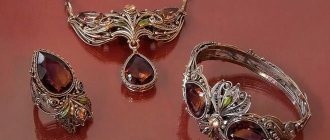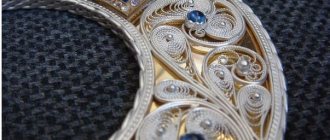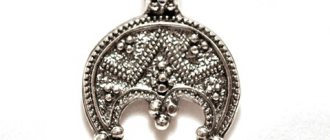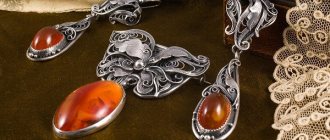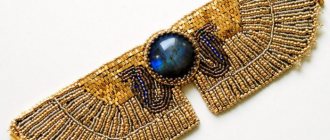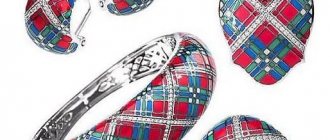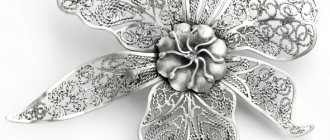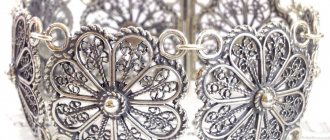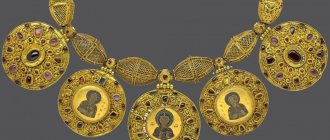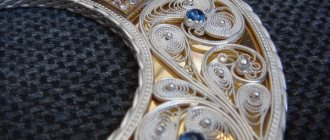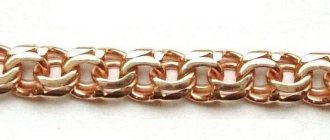This jewelry technique has come down to the present day from time immemorial with minimal changes. Even today, artisans use the same filigree or filigree to create jewelry as their predecessors did many centuries ago. So what is filigree and what is filigree? We understand the concepts and evaluate the works of modern Russian masters.
What is scan
The art of scanning has been known since the second century AD. Over more than 900 years of history, filigree has only become more complex: the blind technique was transformed into openwork, and even refractory steel began to be used instead of soft precious metals.
In Ancient Rus', the first mentions of filigree art appeared in the 9th century. The openwork filigree technique was not yet used at that time, preferring granulation to it, that is, soldering metal balls to jewelry or any other sets and inventing their intricate patterns.
Openwork lace, which is a composition of patterns made of metal wires without a background, has been used since the 12th century. At the same time, jewelers began to complicate the technique, decorating filigree items with precious stones and enamel.
Filigree in ancient Rus'
The art of soldering openwork lace from the finest wire and forming translucent products is called filigree or filigree. Russian craftsmen inked jewelry and tableware, but in the 9th century they learned to cover the jewelry with the finest wire, forming intricate patterns. The development of filigree was influenced by trade; from Europe and Asia, merchants brought jewelry and household items using similar techniques; our craftsmen learned to twist woven material so finely. That they soldered unique patterns.
The growing demand for increasingly complex designs stimulated craftsmen to improve their skills. Buttons preserved from the 16th century, decorated with the finest metal mesh made using the filigree technique, are still of great interest to us today. It was believed that the thinner and more complex the pattern, the nobler and more unique the object.
The heyday of filigree painting occurred between the 18th and 19th centuries. At that time, it was considered as a type of jewelry art and was used not only for making jewelry, but also for painting small objects. All filigree items, whether voluminous panels or just small cigar boxes, were made by hand, although the demand for filigree was very high.
Modern Kazakovsky filigree and price for 2022
Filigree is an art that was hardly damaged during the Soviet era. This was mainly due to the fact that filigree was recognized as a national treasure and a folk historical craft. This allowed her to continue to develop, albeit at a different pace.
To main§ 38. Making filigree products
Filigree are products made from thin wire - smooth, twisted, smooth-rolled and twisted-rolled - forming complex lace patterns (Fig. 107). Filigree, or filigree, is one of the very old and widespread types of jewelry technology, which to this day arouses admiration among lovers and connoisseurs of jewelry and applied art. Filigree products cover almost all types of decorations and household items. There are openwork and background, or soldered, filigree.
Openwork filigree is a lace pattern with a clearly visible end-to-end pattern. Openwork filigree can be flat or voluminous. Flat items include brooches and other flat-shaped items. Examples of volumetric filigree include vases, glass holders, powder compacts, spherical, conical and cylindrical earrings, pendants, etc. Background, or soldered, filigree differs from openwork in that it is soldered onto a specially prepared background made of the same metal. The background can be solid (solid filigree) or filigree (openwork). With a filigree base, the background pattern is made cleaner and, as a rule, of the same type, so as not to distract attention from the main pattern. This type of filigree has a high relief, not only because the design is laid out in two layers, but also because the leaves, petals, rosettes and other filigree elements soldered onto the background are not always flat. They can have complex bends, twists, or even a three-dimensional shape. Like openwork, background filigree can be flat and voluminous. For filigree work, soft metals and alloys are used, capable of being drawn into thin wire, easily soldered, with a relatively high melting point and a beautiful appearance. This is gold, high-grade silver (916), cupronickel, nickel silver, copper. These are used to make blanks for filigree. The types of blanks corresponding to the elements of the filigree pattern are varied and have retained their names for many years - satin stitch, rope, lace, braid, herringbone, track. Surface
- round wire of various sections.
The initial semi-finished product for the billet is ingots, which are rolled in profile rolls of square caliber to a wire of such a cross-section that it can be pulled through a die board. The maximum wire cross-section for jewelry is 1.2 - 1.3 mm, the minimum is 0.2 mm. The preparation of any filigree begins with a round surface, therefore, when preparing the satin surface, the wire is pulled onto all types of filigree. Having a drawing of a filigree product, it is not difficult to determine the length of the workpiece of each element and, consequently, the length of a piece of wire of each section. Pulling the wire (total length) through the holes of the die, cut off pieces of wire of the required section from the tail, so as not to file the grip again. The wire is pulled through, periodically annealing it and making sure that there are no snags or nicks. Wire rolled in flat rolls is called flat satin. The flat surface of large sections often serves as the outline of a filigree pattern. A rope
is a flagellum twisted from two wires.
The cross-section of the wire for twisting can be any and depends on the pattern. Ropes of large sections are used for the contour of a filigree product, small sections - for design elements. To twist the ropes, take an annealed round wire, fold it in half, and one end of the double wire is secured in a special attachment (or hooked to the hook) of the electric motor spindle. Then the wire is tensioned and, holding it in a position stretched along the axis of the spindle, the motor is turned on. As the wire twists, it decreases in length (its tension should be maintained evenly). The twist should not be weak. If the filigree breaks, it is annealed and then continued to be twisted. Usually the twisting lasts until the second break of the filigree. Rope rolled in flat rolls is called flat rope and is one of the most widely used types of filigree. Flattened on the sides, it has a granular surface on the ribs, which creates an amazingly beautiful granular pattern in the product. The thickness of the flattening depends on the cross-section of the rope; So, for a rope twisted from wire with a cross-section of 0.2 - 0.3 mm, the flattening thickness is 0.30 - 0.35 mm. When flattening ropes with a large wire cross-section, the thickness of the flattening also increases. The choice of ropes for flattening depends on the nature of the pattern and the size of the product. All the main elements of filigree are made from flat rope. Lace
is a rope twisted from three or four wires.
It can be made of two ropes. By arranging the pattern of ropes in different ways, a different pattern of cord is obtained. An interesting lace is obtained by twisting wire of various sections or ropes and wire. The lace is twisted, similar to a rope, on a motor, and short sections are twisted by hand. A braid
is a braid tightly woven from three wires.
It is made by hand from short pieces of well-annealed wire and then leveled. Being the side rim of a flat filigree product, a thin wire braid decorates it very effectively. Herringbone
- the herringbone effect is created by two strings lying next to each other with a spiral directed in different directions.
If, according to the sketch, the Christmas tree has a complex bend, then the ropes are soldered together in advance, but if it lies straight or with minor bends, then they are combined in the process of setting filigree. The track is round
- it is a slightly stretched spiral of round smooth surface of small cross-section.
To make it, a thin wire is wound onto a crossbar of the required cross-section (0.5-1.0 mm). The spiral removed from the bolt is slightly stretched so that the gap between the turns is no more than the cross-section of the wire. A round runner is a wonderful decoration that makes individual ornaments stand out from the overall pattern. The path is crumpled
- it looks like a fallen spiral, the rings of which, when piled up, partially cover each other.
The track is made by winding wire in the form of a spiral onto a cylindrical crossbar. The crossbar can be steel wire with a diameter of 1.0 - 3.0 mm, depending on the size of the product and the nature of the pattern. The wire cross-section is also selected individually. Crush the spiral with a light textolite hammer on a straightening plate so that the divergence of the rings is the same. The crumpled track is used as a frame for the corner (ball) and other filigree elements. A variation of the crumpled track is the flattened track. It differs from crumpled one in that it is flattened in flat rolls. The gap between the rolls is set equal to the cross-section of the wire, so that the spiral collapses only in places where the wire overlaps. The divergence of the rings is such that they barely touch each other, and therefore stretch across the track and take the shape of a drop. A flattened track is used in the same cases as a crumpled one, and is no less effective decoration. Zig-zag
- two types of zigzag paths: jagged zig-zag and round zig-zag (snake). Any of these types, collected in one plane in several rows, forms a beautiful openwork uniform background. The gear track is made from flat surface, round and flat rope, the thickness of which ranges from 0.3 to 0.5 mm, using miniature hand-driven gear rollers. The work rolls are special gears, the teeth of which bend the flat workpiece passing between them in a zig-zag manner. The blank for the snake is a flat or round rope, which is wound immediately onto two crossbars (of the same diameter) in a figure eight, as if tying them together. Then the crossbars are removed from the resulting double helix and the spiral is carefully flattened, like a regular track. The fallen double helix is stretched to the width of the link and aligned in a plane to avoid overlaps. Both types of zigzag tracks are used as intermediate elements of openwork filigree, i.e. between two ropes, a cord and a rope, a cast and a rope, etc., as well as in the manufacture of background filigree with an openwork background. All preparation work is carried out with well and evenly annealed filigree. Filigree is not only an independent element of filigree, but also the source material for the manufacture of other elements. The main tools for making filigree elements are filigree tweezers (filigree cutters) and filigree scissors (small jewelry scissors for metal). Filigree tweezers (Fig. 108) are hard tweezers with wide cheeks and sharply tapering (to the needle) working ends (jaws). The length of the tweezers is 120 - 150 mm, the width of the cheeks is 18 - 20 mm, the thickness of the sheet metal on the cheeks is 1.0 - 1.2 mm, the length of the tweezer jaws is 15 - 20 mm. Tweezers are made from stainless steel.
It is difficult to list all the filigree elements from which the pattern is made, but the main ones, repeated many times in the patterns, are ring, half-ring, burdock, asterisk, cucumber, pear, clove, development, petal, corner, tee, head, wall , grass, curl, leaf, curl, bug, rosette, etc. (Fig. 109). The elements have retained their old names, so some of them sound unusual to us.
ring
- made from flat and round satin stitch, round and flat rope.
Well-annealed filigree is wound onto a bolt with a diameter corresponding to the diameter of the ring specified by the pattern, then the spring removed from the bolt is cut along the coil and the ends of the coil are combined. Rings are used to set the background of background filigree, as a basis for some elements - corners, bugs and others, and as an integral part of the elements. A half-ring
is, as the name suggests, part of a ring.
It is obtained from the same filigree and in the same way as the ring, but only part of the coil is cut off from the spring. The beautiful, scaly background of the background filigree is laid out in half rings. In addition, it is used as an independent element and as an integral part of other elements. Burdock
is a filigree element formed by a ring inside and four half rings around the circumference.
It is usually made from flat rope, less often from round rope and flat satin stitch of small cross-section. The asterisk
is assembled, like the burdock, from a ring in the center and half-rings around the circumference, but the number of half-rings is more than four - 5.6 or more.
The radius of the half rings is selected depending on their number. Stars are made from the same material as burdocks. A cucumber
is an element folded from two identical arcs, reminiscent of a “marquise” shape.
The arcs of the cucumber are bent with filigree tweezers and, having determined the length according to the drawing, they are cut off. Typically, cucumbers are prepared from flat or round rope. Pear
- shaped like a drop; the sharp end of the drop can bend to the side.
It is made with filigree tweezers from flat and round rope. A cog
is a corner bent from a flat or round rope, shaped like the outline of a saw or gear tooth.
The clove should have straight antennae; The divergence angle and length of the antennae are determined from the drawing. A razvivashechka
is a clove with curled (curved) antennae.
It is made from the same blank as the clove. Petal
- shaped like a daisy petal.
It is made from flat or round rope or flat satin stitch. Petals of different sizes inserted into each other and connected at the base create beautiful filigree patterns. Corner
is a ball.
Corners are obtained by melting scraps of metal of appropriate sizes. To obtain corners with identical diameters, wire of the same section is cut into identical sections and melted, or thin rolled products are cut with scissors in the form of a brush, and then, by cutting across the ends of the brush, identical sections are obtained. Melting of corners can be done in several ways: on charcoal, and the segments are laid out so that they do not touch each other; small-sized corners melt on the asbestos letkal (for large ones, a platform is formed at the bottom); in a crucible in an environment of charcoal dust or paper ash (a large number of corners are melted). Corners are a great addition to the filigree pattern. They are placed on a ring base: a ring, a central annular section of the head, a wall, a curl, rosettes, etc. A large number of soldered small corners are called grains. A tee
is a trefoil bent with filigree tweezers from a flat or round rope or flat satin stitch.
The head
is a flat-twisted spiral, one end of which forms an arched tail, and the other - a central ring, the center of the spiral head.
The head can have 4, 5, 6 or more turns, depending on the nature and size of the pattern and the thickness of the filigree. The head is wound with tweezers from a flat rope, less often from a round one. Stenek
- has, like a head, on one side an arch curled into a flat spiral, on the other - an end that forms a ring, but this ring is not in the center of the spiral head, but pressed against the arch.
The head of the wall forms, in addition to the ring, one turn, and if the head has two or three turns, the element is called a double or triple wall, respectively. The wall is made in the same way as the head and from the same workpiece. Grass
- is made from a “clove” element with long tendrils, the ends of which curl in one direction in a flat spiral.
The ends curled into a spiral have two or three turns. For weeding, use a flat surface and a flat round rope. Curl
- an arch with the ends curled inward to form rings.
For curls, use flat satin stitch, flat and round rope. The leaflet
is a flat spiral, crumpled from the sides in the form of a leaf.
A spiral circle is made from a flat rope with tweezers, which is then also squeezed from the sides with tweezers so that sharp ends of the leaf are formed. The number of turns in a leaf depends on its size and the thickness of the filigree. The leaf is used as an independent element or in combination with several leaves to form a flower. The produced flat leaf is given a natural bend before typing. Curling
is a trefoil welded into a plane of three leaves of various shapes, which is bent before being set.
A bug
is an element formed by a ring of a round path (spiral) and a corner located in the center.
The cross-section of the wire for the spiral depends on the size of the ring that will be made from this spiral, and the size of the ring depends on the size of the product itself. The spiral ring is bent with tweezers. Solder the corner (it should not fall through and should cover a large section of the spiral) already in the general set of filigree. The bug is planted on the ring base of a previously collected ring of the appropriate size. A rosette
is a spherical concave cup made from a crumpled track with a corner inside.
To make a rosette, as for a bug, a spiral ring is made, which is then coiled in an ank or other spherical matrix. The resulting concave cup is soldered to the corner, also in a common set. The production of filigree elements using tweezers is carried out from a whole (long) piece of filigree, which is cut off only after the element completely matches the pattern. Flat openwork filigree
is typed according to a drawing made on life-size paper.
The design is glued onto a flat template made of low-grade steel sheet with a thickness of 0.5 - 0.8 mm. The dimensions of the template correspond to the dimensions of the drawing. It is advisable to start the set from the outline and continue according to the degree of reduction of the elements. Each element is bent exactly according to the drawing, and only after it completely matches the drawn one is it cut off (with small jewelry scissors). After this, it is smeared from the inside with glue and glued to the drawing, completely replacing the drawn element with the manufactured element. And if there are no more elements identical to it, then proceed to the next one. To set filigree, use BF-2 glue, carpentry glue, cherry glue (gum) or nitro varnish. The typed pattern is allowed to dry, then, so that the pattern does not move during soldering, it is evenly tied to the template with a bindey (knitting wire) and soldered in this form. The use of BF-2 glue and nitro varnish makes it possible to type filigree without binding with a bindra, and therefore without a template. In this case, the pattern drawn on the paper drawing is allowed to dry, and then the paper is carefully peeled off. The film formed by glue or varnish holds the pattern, preventing the elements from falling apart. Soldering is done on a flat asbestos cement slab. Experienced craftsmen, when repeatedly performing the same pattern on paper, do not make a drawing; they only apply an outline, but type filigree into the cells of a regular notebook sheet. Volumetric openwork filigree
can be typed in two ways: in a plane according to the pattern of the development of a volumetric figure and according to a sheet template having the shape of this figure.
The unraveling of volumetric filigree typed in a plane after soldering should take the shape of a given figure. This is achieved by bending the product manually, followed by straightening, bending in matrices (leather, felt, wood, lead, steel with lining) using punches made of the same materials. After giving the product the desired shape, the seams are soldered. A set of voluminous openwork filigree can be made on a curved or concave (bunched) template, similar to a flat set, but the process is very complicated by the fact that not very light elements have to not only be bent according to the pattern, but also bent according to the shape of the template. Such work requires some skill from the filigree maker. Flat background filigree
begins to be typed from the background, similar to openwork, on paper glued to a flat template.
Moreover, not a pattern is drawn on paper (the pattern is usually monotonous), but only an outline within which the pattern is typed. Then, as with openwork filigree, the typed background is soldered, and after bleaching they begin to set the top pattern. Elements of the top pattern They are also made according to a drawing, which, unlike the openwork set, lies nearby. The pattern cannot be glued to the background of the product, because the elements of the top pattern must be soldered to the background. The upper pattern of the background filigree, as a rule, is less common than openwork and the elements of the pattern are not always soldered together. Therefore, the set of the upper pattern does not require such careful adjustment of the elements to each other as with openwork filigree. Having finished setting the top pattern, it is tied to the background, like a template, with knitting wire and soldered. However, it is not always possible to tie the top pattern to the background. Filigree elements with a complex asymmetrical bend and high relief do not allow soldering of the linked product. In such cases, the top pattern is soldered in several stages. Volumetric background filigree
is typed in the same way as flat background filigree. If the three-dimensional figure of the product can be represented in the form of a development, then the background is typed in a plane, soldered, and then shaped into the product. This is achieved using the same methods as in the manufacture of voluminous openwork filigree. If the complex shape of the product excludes the possibility of presenting the product in expanded form, then the background is typed using a tin template that has a three-dimensional shape of the product. The filigree elements for such a set must bend to the shape of the template. In products with complex curvature, for example spherical ones, it is advisable to assemble the background from small elements - rings, half-rings, etc. Sometimes the set is made in fragments (sections), which are then soldered together, forming a three-dimensional figure (Fig. 110). The upper pattern of volumetric filigree is typed in the same ways as a flat one, with the only difference being that the number of soldering techniques can be increased.
Set of blind filigree
- this is a set of finished products made from rolled sheets with a thickness of 0.6 - 1.0 mm.
The product must have a well prepared surface. If polishing is envisaged, the surface serving as the background for the blind filigree must be polished and degreased. The pattern on a blank background, most often simple, is laid out with various filigree: rope, laces, paths and manufactured filigree elements. The set is made so that the pattern fits tightly to the background and is soldered along the entire length of its contact. Soldering is one of the most important operations in the manufacture of jewelry, especially filigree jewelry. Complex, having many small elements soldered together, a filigree product must be distinguished not only by clean execution, but also by reliability in operation. Therefore, special attention is paid to filigree soldering. For soldering, jewelry solders are used that have good fluidity, ductility and a melting point 20 - 4 ° C higher than the melting point of assembly solders. Good fluidity of solder ensures uniform welding of filigree elements and rapid spread of solder over all seams of the heating area. For gold filigree, you should choose solder with the least amount of zinc and cadmium, since these metals not only sharply lower the melting point of the alloy, but also have corrosive properties when the metal overheats. For silver filigree and filigree made of base metals, silver solder is used: Ag - 70%; Cu - 30% or solder fused from 875 silver and copper in a ratio of 4:1. Filigree solders are used in the form of sawdust, mixed with borax. To prepare the mixture, a solder ingot is clamped in a hand-held metal vice and sawdust is cut from it with a coarse file. This is done at the jeweler’s workplace so that the sawdust is collected into cleanly swept leather. When filing solder, try not to touch the finial and other wooden parts of the workbench to prevent wood from getting into the solder. Usually the leather is covered with a sheet of paper, since sawdust can become dusty when sweeping it out of the leather with a brush. Any iron trapped in the sawdust is removed with a magnet, and the sawdust is poured into a jar, where it is mixed with calcined and ground borax in a 1:1 ratio by volume. The mixture is then poured into a cone from which the product is sprinkled. The horn is made from a thin sheet of any metal in the shape of an elongated funnel with a narrow neck through which solder is poured. For more precise cutting of a portion of sawdust, a horn with a valve needle is used. The needle is made of wire with a cross-section equal to the diameter of the neck. One end of the needle is sharpened, and the other is folded into a ring for inserting a finger into it, which is used to regulate the supply of solder, pushing it out with the needle through the neck. A set of filigree tied to a template is moistened with water or a weak solution of borax (for gold and nickel silver, a solution of boric acid) and placed on a letcal, but not on asbestos, but on a metal mesh. The mesh ensures uniform heating of the set from all sides. The set is then sprinkled with a very thin layer of solder (excess solder will flood the design) and heated with a soft flame from a soldering gun. The metal template not only prevents the set from warping, but also helps ensure uniform heating of all filigree elements. Burnt paper (pasted onto the template) placed between the template and the set prevents the set from burning to the template. As soon as the set reaches the melting temperature of the solder, the solder “runs away” along the seams (joints). Places where the elements are not soldered are again sprinkled with solder and heated. Then the set is planted with elements that are not attached, these are: bugs, embossed leaves, rosettes, etc. And last but not least, with corners. The set is sprinkled with solder in the places where the filigree elements touch and heated until it spreads. The soldered filigree is untied from the template, ensuring that no piece of bindra or scale remains from the template, and is bleached. If iron enters the bleach along with the product, it causes a red coating on the product, which is then difficult to remove from the filigree. Only after bleaching can you determine the purity of the soldered joints and the presence of all unsoldered joints. If any are found, they are soldered again. Previous page
| table of contents | Next page |
Filigree - historical background
It is believed that the first masters to master this interesting technique were people from Ancient Egypt and Ancient Greece. The oldest specimens discovered during excavations in ancient cities date back to the 6th century BC.
European masters created unique jewelry for the wealthy bourgeoisie and nobility. The 19th century is rightfully considered the peak of filigree craftsmanship. At this time, jewelry was mass produced and was available to almost all social classes.
Russian filigree originates in ancient times. In Ancient Rus', filigree was primarily ceremonial objects, which then migrated to the caskets of princesses.
Krasnoselskaya filigree (Kostroma)
At an exhibition in Paris in 1937, the famous “Krasnoselskaya filigree” created a world sensation. This success was repeated two years later in New York.
Where can you buy real filigree jewelry?
Unfortunately, finding true filigree is not so easy. Not all jewelry enterprises (and KPHI is a typical example) disclose on their websites the names of retail chains with which they cooperate to sell products. As a result, you can completely accidentally “come across” scanned items by simply going to a regular jewelry store near your home - with the same success as not finding it at all, having walked around a dozen stores.
One of the more reliable ways today is to attend jewelry exhibitions, which are regularly held in Moscow and other large cities (jewelry exhibition calendars). More or less serious jewelry companies from different parts of the country are represented there, making jewelry using a wide variety of techniques. And you can even meet those manufacturers who do not sell through stores at all, whose assortment can be seen exclusively at exhibitions.
If you wish, you can also try searching for filigree products made in different countries (including eastern ones - Nepal, Thailand) in online stores, as well as on the websites of private jewelers, websites for collectors, or foreign stores or hand-made resources like etsy.com. On the latter you can find beautiful antique specimens.
As we find manufacturers and retailers offering real filigree, we will add them to our Manufacturer Directory and Seller Directory, where you can find them by specifying your search parameters.
Products with “filigree elements” versus “true filigree”
Jewelry almost always contains filigree elements: a scattering of beads of grain, a cord or rope of metal around an insert with a stone or pearl. Sometimes filigree curls and grains are soldered onto cast or stamped parts of the jewelry. On the one hand, this is no longer completely filigree and not purely handmade. But such “combi-filigree” is often stronger, cheaper and more accessible than its noble “cousin” - pure hand-made filigree.
The balance of aesthetics and practicality will give the buyer the desired vector. Let's say the strength of the earlobe is not limitless. And your goal is voluminous earrings or a pendant. In openwork hand-made filigree, the ratio of dimensions to weight is the most humane, perhaps this is “to your advantage” (to your ears). Bracelets and rings may require greater strength, and then “mixed” filigree will seem “stronger” than filigree. The main thing, as always, is to understand the difference between true filigree and its imitation, consciously giving money for this or that product.
For comparison: on the left is a ring with “filigree elements”, on the right is a filigree bracelet
Variety of filigree work
There are many ways to add variety to the filigree technique: using enamel and gemstones, using wire patterns on niello, or a combination of filigree techniques.
There are a total of 3 main types of this jewelry art:
Soldered filigree
It is a jewelry making technique in which a wire pattern is soldered onto a sheet of metal. It is quite often combined with enamel and differs in the type of background (faded) filigree, chased (bordered) filigree, cloisonné enamel, etc.
Openwork filigree
The openwork technique involves connecting wire parts without soldering them to any substrate. Making metal lace requires a lot of experience in working with metals and careful soldering. An addition to this technique are metal balls soldered to the lace elements.
Volumetric filigree
To make voluminous filigree jewelry, a step-by-step method is used: several elements made in openwork filigree are combined into one composition.
filigree and enamel in one decoration
Using the technique of filigree from precious metals, you can create colorful combinations with various materials: precious and semi-precious stones, enamel , unglazed silver, glass and wood.
The variety of inlays in filigree jewelry required great skill in working with metals. For example, to complete a niello ornament, it was necessary to sprinkle the product with an alloy of several metals and fire it so that the molten niello filled the relief pattern.
Initially, filigree masters chose only precious metals such as gold and silver, preferring the former due to a number of its qualities:
- Firstly, gold is a very fusible metal, i.e. heating it to a “sticky” state requires a temperature much lower than the melting point of steel or iron.
- Gold is an extremely ductile material. With high purity, it is easily deformed even without heating.
- Gold is a fairly economical material. This means that from a relatively small amount of this metal it is possible to pull out an impressive length of gold wire consisting of disparate patterns: rings, arcs and vortices.
Gold Filigree Spoon and Cup and Saucer
This precious metal has been highly valued throughout human history. The richest members of society decorated themselves with gold objects, the manufacturing techniques of which became more and more complex over time. Gold ornaments of Russian filigree decorated cases for icons, basmas and earrings.
Types of jewelry filigree
Filigree can be soldered, openwork and voluminous. In brazed filigree, wires and grains are soldered directly onto sheet metal. If the background is left, it is background or “blank” filigree. When, after soldering, the background is removed (by notching or sawing), then this is notched or sawn filigree.
In embossed relief filigree, the pattern is soldered onto the embossed relief.
In openwork filigree there is no metal base: the wire pattern is soldered on itself, and the grain is attached directly to the metal lace. If the “lace” is flat, then it is flat openwork filigree. If the lace is soldered in two dimensions and is voluminous (three-dimensional relief or high relief), then it is sculptural-relief openwork filigree. “Russian filigree” in foreign sources .
Volumetric filigree - cups, vases, trays, caskets and buildings, and even creatures - birds, animals. It is created in parts and then assembled into a single composition.
In jewelry they use both flat (frame pendants), and openwork-volume (hemispherical complex brooches and rings, link and “solid” bracelets), and sculptural (animals, birds, bells) openwork filigree made of silver and other metals.
Who owns the filigree technique?
It would be a mistake to consider that filigree is a purely Russian craft. The traditions of filigree art are alive in modern schools in different countries. The filigree of Armenia is subtlety and flatness, of Dagestan - an abundance of grains and hemispheres, of Kostroma - complex volumetric shapes. Products using the filigree technique are produced by jewelers from various countries - France, Italy... Painfully familiar silver openwork patterns can unexpectedly be found in jewelry, for example, from Ecuador. And you shouldn’t be surprised by this, because it is in Latin America that ancient “silver” crafts, including filigree, are especially alive.
Examples of Ecuadorian filigree jewelry:
Filigree in mass production
In the 17th century, the demand for embossed jewelry increased, and serious jewelry in the Scanción style appeared, in which, in addition to stones, crystals and mother-of-pearl were used. The craftsmen also did not forget about making various household items: vases, salt shakers and boxes. Since the 19th century, filigree has become a manufactured product. Technologies improved, openwork filigree flourished, and translucent stained glass windows appeared - openwork filigree with transparent enamel.
After a decline at the beginning of the 20th century, the filigree technique regained its strength beginning in the middle of the century. In 1937, the works of craftsmen from the village of Krasnoe-on-Volga (“Krasnoselsky craftsman”, near Kostroma) were shown at the World Exhibition in Paris, where they accepted gold for filigree brooches, boxes and other accessories, and in 1939 in New York .
Modern brand Kazakovskaya filigree
Kazakovskaya filigree (photo from the main website of the plant)
Today Kazakova’s Art Products (KAZAKOVKA) (KPHI) is a serious “filigree” brand, specializing primarily in products using this technique. KPHI brand jewelry is usually made of silver plated alloy.
What are the specifics of Kazakh filigree? When creating a pattern, the master pays attention to the harmony of its individual parts, the beauty of the lines of the largest and thinnest elements. The artist works on the design of the slots, which is very important when creating patterns. The charm of Cossack products lies in their openness - appreciate the beauty of the work in the photo.
Filigree 'Kubachi'
Kubachi jewelers (kubachi.su), along with the techniques of blackening, stamping and engraving traditionally known in Dagestan, also produce filigree jewelry of extraordinary beauty.
Russian masterpieces
Filigree (along with graining) has become one of the most famous jewelry making techniques in Russia. Workshops for the production of jewelry and exquisite utilitarian items were located at princely courts and monasteries. Over the course of many centuries, Russian jewelers improved this technology.
In the 18th and 19th centuries, there were several factories producing filigree items. Original filigree artwork includes rings, wedding rings, brooches, pendants, amulets and rattles. Even binoculars and lighters were decorated in this technique, which was part of the Art Nouveau style.
Forge or pull
Jewelry masterpieces created using filigree techniques existed before our era. The difference from ancient Russian filigree is determined by the method of making wire from precious metals or alloys. The wire was forged or the workpiece was pulled through a drawing device, resulting in a thin jewelry thread. In Ancient Egypt and Greece, forging was used to make it.
14th century gold filigree boxes
Old Russian masters, starting from the 10th century, made filigree silver and gold carvings using the second method - according to a drawing. The best way to see what was made from skaj centuries ago is to visit museums. There are excellent examples of princely household items and church vessels, decorated with fabulous ornaments. Clothing (shoes, belts, etc.), book covers, dishes, crosses - filigree patterns flourished everywhere. It is worth recalling that Monomakh's hat is decorated with filigree.
Secrets of mastery
Creating jewelry using the filigree method is a complex and multi-step process that requires certain skills and equipment. Precious metal wire is pre-rolled and twisted to the desired thickness. Some jewelers leave the blank smooth to bring their design ideas to life.
All work, except for preparation of blanks, is carried out entirely by hand. Moreover, the lace itself is based on only a few traditional elements. These include ring, gear, curl, clove, burdock and grass.
To create a unique product, it is important to draw a sketch on paper in advance. It must be made in full size. It is based on this that the size of real parts is adjusted by applying it to a sheet of paper.
When the drawing is assembled, it is soldered, and the paper base itself is burned so that it does not leave traces. When working in volume, parts are glued together “in weight”.
Once the assembly process is complete, the metal is dipped into a special chemical solution to make the filigree piece shine. Often the surface is additionally polished.
How is filigree jewelry made?
The elements of a filigree pattern are rope, cord, weaving, herringbone, track, satin stitch, and so on. It is essentially a lace appliqué made from metallic thread. Filigree is often combined with granulation - small balls that are soldered into prepared cells (recesses). Granulation gives filigree a particularly elegant, sophisticated look. Alloys of gold, silver and platinum, as well as copper, brass, nickel silver, and nickel silver are used as materials for the manufacture of products. All types of jewelry can be made using the filigree technique.
Materials for filigree
Since ancient times, it was believed that silver and gold were best suited for filigree. These noble, soft and impurity-free metals are easily drawn into wire. For example, a thread that can be made from 1 gram of gold will be about 2500 meters long.
However, scanned items made from precious metals are very expensive, so other materials have begun to be used to make them cheaper.
First of all, copper, because it has high ductility and softness. In addition, copper thread can be easily silvered or gilded.
Aluminum, cupronickel, brass and some other metals are also used. The main thing is to be able to pull a thin wire out of them. After all, filigree is a product consisting of wire patterns.
False scan
The methods reduce production costs by speeding up the process. False (cast) filigree and grain are products cast in prefabricated molds from slate and limestone. The pattern is not formed by the artist, but is poured into a form. These decorations are similar to the original filigree decorations, but differ in simpler, uncomplicated patterns without relief.
If you liked the article, share it on social networks, it’s important to us
Tags: features of jewelry technology since the times of ancient Rus', Filigree and filigree - what is it
Punch (diff)
Defeating is an ancient technique of cold processing of sheet metal, produced by direct blows of a hammer, under which it stretches, bends, shrinks and, as a result, acquires the required shape. Differing differs from blacksmith forging in that it is produced in a cold state, while during forging the metal is heated red-hot. In addition, it is made of sheet metal no thicker than 2 mm; forging work is usually carried out from a massive billet. Diffing differs from embossing in that it is performed directly with a hammer, and embossing (and wooden ones at that) is rarely used.
Currently, in the field of artistic processing, the following types of shaping can be distinguished: free hand punching, mechanized punching, model punching.
Free hand punch. This is an ancient technique, but it is still used today. The goal of this technique is to create a hollow volumetric product from sheet metal.
Obtaining a three-dimensional shape from a flat workpiece is determined by three processes, which in various alternations and combinations constitute a free hand punch.
The first process is the flattening of a workpiece lying on a steel anvil by blows of a steel hammer, i.e., an increase in area due to a decrease in thickness, which occurs if the hammer is evenly struck over the entire surface of the workpiece. If blows are applied to a small, limited area of the sheet, without touching its edges, then the workpiece will not only be flattened - decrease in thickness in the place where the blow is struck, but at the same time deform, i.e., form a spherical surface, concave with sides of impact. This happens because the parts of the sheet untouched by the impact prevent the material from spreading out to the sides.
The second process is the bending of a sheet blank, when the concave side undergoes compression and the convex side undergoes tension. Bending is done with a steel (or wooden) hammer on the edge of the anvil. Bending can occur at an angle and along a radius, in a straight line, along an arc and along a complex curve. This is achieved due to the fact that the rib of a shaped anvil of the appropriate shape is selected as a support; in this case, not only bending occurs, but also stretching of the metal.
The third process is metal precipitation, i.e., as a result of the impact, the thickness (cross section) of the material increases. To do this, the workpiece is first corrugated, and then the corrugations are upset (“drawn out”) with a steel or wooden hammer on an anvil. This work process is the most complex and requires the appropriate skills from the performer. Corrugations, for example, should be low and wide, making them easier to upset. Tall and narrow corrugations push against each other during settlement, resulting in the formation of cracks and folds. It is very important that the corrugations are not piled on one side or undercut. In addition, the jaws of round nose pliers or special corrugators must be hardened and polished, otherwise damage may appear on the metal surface during the corrugation process.
The tools used for punching are divided into two groups: percussion and support.
A free drift can be used to process a wide variety of metals and their alloys: gold, silver, copper, brass, tombac, aluminum, nickel alloys and steel. However, free-punching is a slow and labor-intensive process, so it is only applicable for making the first original designs in metal. But in all cases where this is possible, it should be replaced with more modern and productive methods: pressing on a machine or modeling according to a model, and also use special mechanisms.
Punching according to models. This method is currently used for the production of artistic bas-reliefs and round (volume) sculptures made of copper, brass and aluminum, as well as stainless steel. This technique can be used to produce large exterior decorative works, monumental figures for monuments and interior art sculpture.
Monuments made by casting are much more economical than cast ones - the metal consumption is less, they are lighter in weight, and easy to transport; Being installed on steel frames, they are quite strong and durable.
